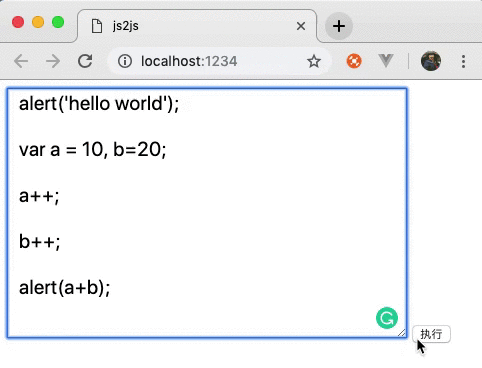这篇文章主要介绍了如何使用js写一个js解释器,具有一定借鉴价值,感兴趣的朋友可以参考下,希望大家阅读完这篇文章之后大有收获,下面让小编带着大家一起了解一下。
先来看一下效果

一个最简单的解释器
上面有提到,js 有个特性是 对象属性可以用字符串表示,如 console.log 等价于 console['log'], 辣么根据这个特性,我们可以写出一个兼容性极差,极其简陋的雏形
function callFunction(fun, arg) {
this[fun](arg);
}
callFunction('alert', 'hello world');
// 如果你是在浏览器环境的话,应该会弹出一个弹窗既然是简易版的,肯定是问题一大堆,js 里面得语法不仅仅是函数调用,我们看看赋值是如何用黑魔法实现的
function declareVarible(key, value) {
this[key] = value;
}
declareVarible.call(window, 'foo', 'bar');
// window.foo = 'bar'Tips: const 可以利用 Object.defineProperty 实现;
如果上面的代码能看懂,说明你已经懂得了 js 解释器 的基本原理了,看不懂那只好怪我咯。
稍微加强一下
可以看出,上面为了方便, 我们把函数调用写成了 callFunction('alert', 'hello world'); 但是着看起来一点都不像是 js 解释器,
我们心里想要的解释器至少应该是长这样的 parse('alert("hello world")''), 那么我们来稍微改造一下, 在这里我们要引入 babel 了,
不过先不用担心, 我们解析出来的语法树(AST)也是很简单的。
import babelParser from '@babel/parser';
const code = 'alert("hello world!")';
const ast = babelParser.parse(code);以上代码, 解析出如下内容
{
"type": "Program",
"start": 0,
"end": 21,
"body": [
{
"type": "ExpressionStatement",
"start": 0,
"end": 21,
"expression": {
"type": "CallExpression",
"start": 0,
"end": 21,
"callee": {
"type": "Identifier",
"start": 0,
"end": 5,
"name": "alert"
},
"arguments": [
{
"type": "Literal",
"start": 6,
"end": 20,
"value": "hello world!",
"raw": "\"hello world!\""
}
]
}
}
],
"sourceType": "module"
}上面的内容看起来很多,但是我们实际有用到到其实只是很小的一部分, 来稍微简化一下, 把暂时用不到的字段先去掉
{
"type": "Program",
"body": [
{
"type": "ExpressionStatement",
"expression": {
"type": "CallExpression",
"callee": {
"type": "Identifier",
"name": "alert"
},
"arguments": [
{
"type": "Literal",
"value": "hello world!",
}
]
}
}
],
}我们先大概浏览一遍 AST 里面的所有属性名为 type 的数据
ExpressionStatement
CallExpression
Identifier
Literal
一共有 4 种类型, 那么接下来我们把这 4 种节点分别解析, 从最简单的开始
Literal
{
"type": "Literal",
"value": "hello world!",
}针对 Literal 的内容, 我们需要的只有一个 value 属性, 直接返回即可.
if(node.type === 'Literal') {
return node.value;
}是不是很简单?
Identifier
{
"type": "Identifier",
"name": "alert"
},Identifier 同样也很简单, 它代表的就是我们已经存在的一个变量, 变量名是node.name, 既然是已经存在的变量, 那么它的值是什么呢?
if(node.type === 'Identifier') {
return {
name: node.name,
value:this[node.name]
};
}上面的 alert 我们从 node.name 里面拿到的是一个字符, 通过 this['xxxxx'] 可以访问到当前作用域(这里是 window)里面的这个标识符(Identifier)
ExpressionStatement
{
"type": "ExpressionStatement",
"expression": {...}
}这个其实也是超简单, 没有什么实质性的内容, 真正的内容都在 expression 属性里,所以可以直接返回 expression 的内容
if(node.type === 'ExpressionStatement') {
return parseAstNode(node.expression);
}CallExpression
CallExpression 按字面的意思理解就是 函数调用表达式,这个稍微麻烦一点点
{
"type": "CallExpression",
"callee": {...},
"arguments": [...]
}CallExpression 里面的有 2 个我们需要的字段:
callee 是 函数的引用, 里面的内容是一个 Identifier, 可以用上面的方法处理.
arguments 里面的内容是调用时传的参数数组, 我们目前需要处理的是一个 Literal, 同样上面已经有处理方法了.
说到这里,相信你已经知道怎么做了
if(node.type === 'CallExpression') {
// 函数
const callee = 调用 Identifier 处理器
// 参数
const args = node.arguments.map(arg => {
return 调用 Literal 处理器
});
callee(...args);
}代码
这里有一份简单的实现, 可以跑通上面的流程, 但也仅仅可以跑通上面而已, 其他的特性都还没实现。
https://github.com/noahlam/practice-truth/tree/master/js2js
其他实现方式
除了上面我介绍得这种最繁琐得方式外,其实 js 还有好几种可以直接执行字符串代码得方式
1.插入 script DOM
const script = document.createElement("script");
script.innerText = 'alert("hello world!")';
document.body.appendChild(script);2.eval
eval('alert("hello world!")')3.new Function
new Function('alert("hello world")')();4.setTimeout 家族
setTimeout('console.log("hello world")');感谢你能够认真阅读完这篇文章,希望小编分享的“如何使用js写一个js解释器”这篇文章对大家有帮助,同时也希望大家多多支持亿速云,关注亿速云行业资讯频道,更多相关知识等着你来学习!
亿速云「云服务器」,即开即用、新一代英特尔至强铂金CPU、三副本存储NVMe SSD云盘,价格低至29元/月。点击查看>>
免责声明:本站发布的内容(图片、视频和文字)以原创、转载和分享为主,文章观点不代表本网站立场,如果涉及侵权请联系站长邮箱:is@yisu.com进行举报,并提供相关证据,一经查实,将立刻删除涉嫌侵权内容。